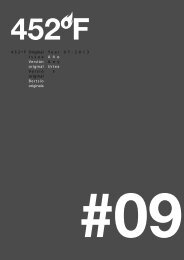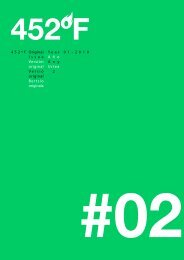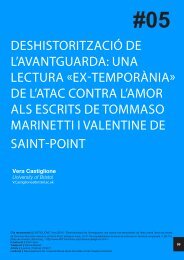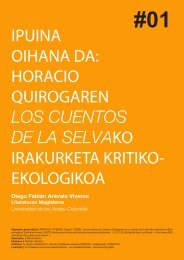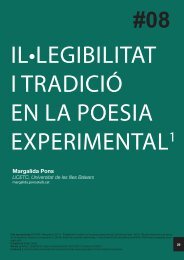03 - 452ºF
03 - 452ºF
03 - 452ºF
Create successful ePaper yourself
Turn your PDF publications into a flip-book with our unique Google optimized e-Paper software.
As I stated at the beginning of my paper, I intend to ask whether<br />
self- or life-writing is –in this case– a kind of stratagem that opens<br />
up ambiguous spaces of possibility where a subject of violent history<br />
and an agent of discourse might engage with one another; where<br />
new modes of interaction between the personal and the political<br />
might be meaningfully explored. In this respect, an outline of the<br />
major events of the war is helpful. I especially want to highlight the<br />
political confusion of the Algerian war and the extreme polarization<br />
that occurred as the violence increased; and the strife among different<br />
factions of the liberation struggle and within the FLN itself, essentially<br />
erased or mythologized in the official history that was developed by<br />
the Algerian regime (although this is slowing unravelling). It is useful<br />
to draw attention to these facts in order to situate the critique which<br />
subtends the novel examined in the following sections of my paper.<br />
2. Le Cow-boy<br />
In the first pages of Le Cow-boy, Lachmet describes the initial<br />
encounter between Lallia, a middle-class Muslim Algerian girl, and<br />
René, the son of French settlers. At the annual pageant the school<br />
children wear costumes for a play at the town hall. Lallia, the smallest<br />
girl in her class, is a daisy. Admiring her costume in a mirror before<br />
the performance she notices a blonde head in the reflection. As she<br />
turns to catch the person watching her, she spots the brim of a hat<br />
disappearing behind a column. A boy is smiling at her: «Je jette un<br />
coup d’oeil dans le miroir pour vérifier ma tenue, quelque chose<br />
est peut-être de travers» [I glance in the mirror to check my outfit,<br />
something may be wrong] (Lachmet, 1983: 30). He wears a cowboy<br />
hat with a badge in the shape of a bull’s horns and has a toy revolver<br />
in his belt. She asks if he is chasing robbers: «Non, je suis un cowboy<br />
du Far West» [No, I’m a cowboy from the Wild West] (ibid). Borrowed<br />
from American popular culture, the cowboy is a widely-recognized<br />
romantic symbol of the colonial settler. In the US context, the cowboy<br />
and the Wild West are icons in an intricate mythology constructed<br />
around the experience of westward expansion at the turn of the<br />
nineteenth century. As popular culture scholar John Cawelti points<br />
out, this was the era of the modern adult western novel, exemplified<br />
by the stories of Owen Wister, Emerson Hough, Harold Bell Wright,<br />
and Zane Grey. It was the zenith of the Wild West Show and the<br />
Rough Riders, when Theodore Roosevelt exploited the myth of the<br />
cowboy and the Wild West for political purposes. American history<br />
witnessed the debut of Frederick Jackson Turner’s frontier thesis,<br />
and the first western genre films. In his essay, «The Significance<br />
of the Frontier in American History», Turner argues that the rise of<br />
urbanization resulted in these cowboy mythologies. They became<br />
increasingly important in the imagination of American culture since<br />
«Je suis un cowboy du Far West»: A study of textual métissage in Djanet Lachmet’s autobiographical novel Le Cow-boy (1983) - Caroline Kelley<br />
<strong>452ºF</strong>. #<strong>03</strong> (2010) 85-101.<br />
90



